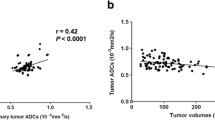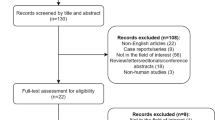Abstract
Our study aimed to identify diffusion-weighted imaging (DWI) parameters obtained from primary nasopharyngeal carcinoma (NPC) at initial presentation, that can predict patients at risk of distant metastases. One hundred and sixty-four patients underwent pretreatment magnetic resonance imaging and DWI. The apparent diffusion coefficient (ADC)mean, ADCskewness, and ADCkurtosis were obtained by histogram analysis. Univariate and multivariate analyses of these ADC parameters together with primary volume (PV), nodal volume (NV), T stage, N stage and presence of locoregional relapse (LRR) were compared between patients with distant metastases (DM+) and patients without distant metastases (DM−) at 5 years using logistic regression. Twenty-eight out of 164 patients (17.1 %) were DM+ (2.5–60 months) and 136/164 patients were DM− (61.2–119.4 months). Compared to DM− patients, the primary tumour of DM+ patients showed significantly lower ADCskewness (ADC values with the greatest frequency were higher) (p = 0.041), and higher PV (p = 0.022), NV (p < 0.01), T stage (p = 0.023), N stage (p < 0.01) and LRR (p < 0.01). On multivariate analysis the ADCskewness was no longer significant (p = 0.120) and only NV and LRR were independent predictors for DM+ (p = 0.023 and 0.021, respectively). DWI showed that compared to DM− patients, DM+ patients had a significantly lower primary tumour ADCskewness, but at initial presentation NV was the only independent predictor of DM.

Similar content being viewed by others
References
Lee AWM, Ma BBY, Ng WT, Chan ATC (2015) Management of nasopharyngeal carcinoma: current practice and future perspective. J Clin Oncol 33:3356–3364
Chan ATC, Teo PML, Johnson PJ (2002) Nasopharyngeal carcinoma. Ann Oncol 13:1007–1015
Lin S, Tham IWK, Pan J et al (2012) Combined high-dose radiation therapy and systemic chemotherapy improves survival in patients with newly diagnosed metastatic nasopharyngeal cancer. Am J Clin Oncol 35:474–479
Lu X, Kang Y (2010) Hypoxia and hypoxia-inducible factors: master regulators of metastasis. Clin Cancer Res 16:5928–5935
Hong B, Lui VWY, Hashiguchi M et al (2013) Targeting tumor hypoxia in nasopharyngeal carcinoma. Head Neck 35:133–145
Hatakenaka M, Nakamura K, Yabuuchi H et al (2011) Pretreatment apparent diffusion coefficient of the primary lesion correlates with local failure in head-and-neck cancer treated with chemoradiotherapy or radiotherapy. Int J Radiat Oncol Biol Phys 81:339–345
Nordsmark M, Overgaard J (2000) A confirmatory prognostic study on oxygenation status and loco-regional control in advanced head and neck squamous cell carcinoma treated by radiation therapy. Radiother Oncol 57:39–43
Junttila MR, de Sauvage FJ (2013) Influence of tumour micro-environment heterogeneity on therapeutic response. Nature 501:346–354
Driessen JP, Caldas-Magalhaes J, Janssen LM et al (2014) Diffusion-weighted MR imaging in laryngeal and hypopharyngeal carcinoma: association between apparent diffusion coefficient and histologic findings. Radiology 272:456–463
Zhang XL, Jiang C, Zhang ZX et al (2014) The tumor-stroma ratio is an independent predictor for survival in nasopharyngeal cancer. Oncol Res Treat 37:480–484
Kim S, Loevner L, Quon H et al (2009) Diffusion-weighted magnetic resonance imaging for predicting and detecting early response to chemoradiation therapy of squamous cell carcinomas of the head and neck. Clin Cancer Res 15:986–994
Ohnishi K, Shioyama Y, Hatakenaka M et al (2011) Prediction of local failures with a combination of pretreatment tumor volume and apparent diffusion coefficient in patients treated with definitive radiotherapy for hypopharyngeal or oropharyngeal squamous cell carcinoma. J Radiat Res 52:522–530
Hatakenaka M, Shioyama Y, Nakamura K et al (2011) Apparent diffusion coefficient calculated with relatively high b-values correlates with local failure of head and neck squamous cell carcinoma treated with radiotherapy. Am J Neuroradiol 32:1904–1910
Lambrecht M, Van Calster B, Vandecaveye V et al (2014) Integrating pretreatment diffusion weighted MRI into a multivariable prognostic model for head and neck squamous cell carcinoma. Radiother Oncol 110:429–434
Ng SH, Lin CY, Chan SC et al (2014) Clinical utility of multimodality imaging with dynamic contrast-enhanced MRI, diffusion-weighted MRI, and 18F-FDG PET/CT for the prediction of neck control in oropharyngeal or hypopharyngeal squamous cell carcinoma treated with chemoradiation. PLoS One 9:e115933
Noij DP, Pouwels PJW, Ljumanovic R et al (2015) Predictive value of diffusion-weighted imaging without and with including contrast-enhanced magnetic resonance imaging in image analysis of head and neck squamous cell carcinoma. Eur J Radiol 84:108–116
Zhang Y, Liu X, Zhang Y et al (2015) Prognostic value of the primary lesion apparent diffusion coefficient (ADC) in nasopharyngeal carcinoma: a retrospective study of 541 cases. Sci Rep 5:12242
Law BKH, King AD, Bhatia KS et al (2016) Diffusion-weighted imaging of nasopharyngeal carcinoma: can pretreatment DWI predict local failure based on long-term outcome? Am J Neuroradiol 37:1706–1712
Hsu MM, Tu SM (1983) Nasopharyngeal carcinoma in Taiwan clinical manifestations and results of therapy. Cancer 52:362–368
Li A, Xiao W, Shen G et al (2015) Distant metastasis risk and patterns of nasopharyngeal carcinoma in the era of IMRT: long-term results and benefits of chemotherapy. Oncotarget 6:24511–24521
van den Brekel MW, Stel HV, Castelijns JA et al (1990) Cervical lymph node metastasis: assessment of radiologic criteria. Radiology 177:379–384
Edge SB, Byrd DR, Compton CC et al (2010) AJCC cancer staging manual, 7th edn. Springer, New York
Nguyen DX, Massagué J (2007) Genetic determinants of cancer metastasis. Nat Rev Genet 8:341–352
Yokota J (2000) Tumor progression and metastasis. Carcinogenesis 21:497–503
Bonomi M, Patsias A, Posner M, Sikora A (2014) The role of inflammation in head and neck cancer. Adv Exp Med Biol 816:107–127
Fernandes JV, Cobucci RNO, Jatobá CAN et al (2015) The role of the mediators of inflammation in cancer development. Pathol Oncol Res 21:527–534
Payen VL, Porporato PE, Baselet B, Sonveaux P (2016) Metabolic changes associated with tumor metastasis, part 1: tumor pH, glycolysis and the pentose phosphate pathway. Cell Mol Life Sci 73:1333–1348
Porporato PE, Payen VL, Baselet B, Sonveaux P (2016) Metabolic changes associated with tumor metastasis, part 2: mitochondria, lipid and amino acid metabolism. Cell Mol Life Sci 73:1349–1363
Kwong D, Sham J, Choy D (1994) The effect of loco-regional control on distant metastatic dissemination in carcinoma of the nasopharynx: an analysis of 1301 patients. Int J Radiat Oncol Biol Phys 30:1029–1036
Lee AWM, Sze WM, Au JSK et al (2005) Treatment results for nasopharyngeal carcinoma in the modern era: the Hong Kong experience. Int J Radiat Oncol Biol Phys 61:1107–1116
Chua DT, Sham JS, Kwong DL et al (1997) Volumetric analysis of tumor extent in nasopharyngeal carcinoma and correlation with treatment outcome. Int J Radiat Oncol Biol Phys 39:711–719
Ng WT, Lee AWM, Kan WK et al (2007) N-staging by magnetic resonance imaging for patients with nasopharyngeal carcinoma: pattern of nodal involvement by radiological levels. Radiother Oncol 82:70–75
Chen KW, Wang WY, Liang WM et al (2011) The volume of retropharyngeal nodes predicts distant metastasis in patients with advanced nasopharyngeal carcinoma. Oral Oncol 47:1171–1175
Lee AWM, Ng WT, Chan LK et al (2012) The strength/weakness of the AJCC/UICC staging system (7th edition) for nasopharyngeal cancer and suggestions for future improvement. Oral Oncol 48:1007–1013
Yue D, Xu YF, Zhang F et al (2014) Is replacement of the supraclavicular fossa with the lower level classification based on magnetic resonance imaging beneficial in nasopharyngeal carcinoma? Radiother Oncol 113:108–114
Jiang F, Jin T, Feng XL et al (2015) Long-term outcomes and failure patterns of patients with nasopharyngeal carcinoma staged by magnetic resonance imaging in intensity-modulated radiotherapy era: the Zhejiang Cancer Hospital’s experience. J Cancer Res Ther 11(Suppl 2):C179–C184
Lee AWM, Foo W, Poon YF et al (1996) Staging of nasopharyngeal carcinoma: evaluation of N-staging by Ho and UICC/AJCC systems. Union Internationale Contre le Cancer. American Joint Committee for Cancer. Clin Oncol 8:146–154
Mao YP, Liang SB, Liu LZ et al (2008) The N staging system in nasopharyngeal carcinoma with radiation therapy oncology group guidelines for lymph node levels based on magnetic resonance imaging. Clin Cancer Res 14:7497–7503
Wu Z, Gu M, Zeng R et al (2013) Correlation between nasopharyngeal carcinoma tumor volume and the 2002 International Union Against Cancer tumor classification system. Radiat Oncol 8:87
Feng M, Wang W, Fan Z et al (2013) Tumor volume is an independent prognostic indicator of local control in nasopharyngeal carcinoma patients treated with intensity-modulated radiotherapy. Radiat Oncol 8:208
Thoeny HC, De Keyzer F, King AD (2012) Diffusion-weighted MR imaging in the head and neck. Radiology 263:19–32
Author information
Authors and Affiliations
Corresponding author
Ethics declarations
Conflict of interest
The authors declare that they have no conflict of interest.
Ethical approval
All procedures performed in studies involving human participants were in accordance with the ethical standards of the institutional and/or national research committee and with the 1964 Helsinki declaration and its later amendments or comparable ethical standards. For this type of study formal consent is not required.
Rights and permissions
About this article
Cite this article
Ai, QY., King, A.D., Law, B.K.H. et al. Diffusion-weighted imaging of nasopharyngeal carcinoma to predict distant metastases. Eur Arch Otorhinolaryngol 274, 1045–1051 (2017). https://doi.org/10.1007/s00405-016-4333-6
Received:
Accepted:
Published:
Issue Date:
DOI: https://doi.org/10.1007/s00405-016-4333-6




